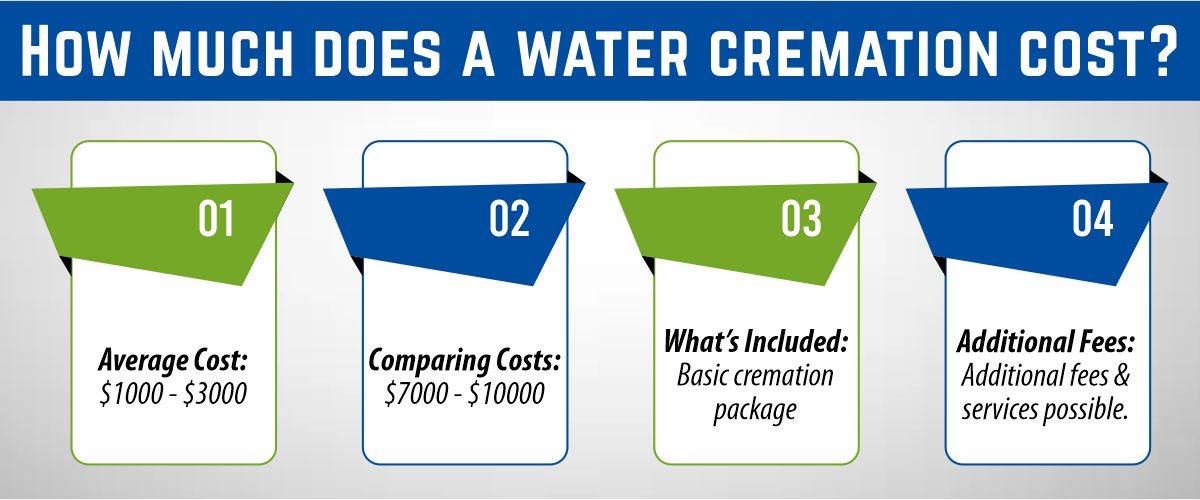Last Updated on: July 31st, 2024
Reviewed by Dylan Whitman
- Licensed Agent
- - @M-LifeInsurance
Aquamation, also referred to as water cremation, alkaline hydrolysis, and resomation, is a process of dissolving human remains that is more ecologically friendly and affordable than traditional burial or cremation. But why is water cremation illegal in many areas of the United States? Alkaline hydrolysis, which has a lower environmental footprint than traditional flame cremation, has been used in Canada, the USA, and some other countries for more than a decade. It will shortly be available in the UK for the first time.
But what is it, how does it work and what environmental benefits does it bring?
Let’s find it out:
What is water cremation?
Water cremation also referred to as alkaline hydrolysis is a water-based method of body disposal that accelerates a post-mortem process by subjecting it to pressure, heat, and water as well as alkali, and potassium hydroxide. This process is an intensified form of a reaction that occurs when a body is buried in the soil. Unlike flame cremation, water cremation safely oxidizes the body to ashes without resorting to fire and heat. It also yields approximately 20 to 30 percent more ashes.
What is the water cremation process?
The water process starts with placing the body in a stainless steel vessel. The vessel is filled with water and alkali (potassium hydroxide), an odorless, off-white flaky, or lumpy solid. The ratio of the alkali solution is typically 95 percent water to five percent alkali, but it may vary depending on body characteristics (e.g., height).
– The Breakdown Process
The vessel is exposed to high temperatures (200 to 320 F / 93 to 160 C) and agitation to prevent boiling and help break down organic material. The solution reduces compounds in the body to organic components (e.g., fats are reduced to salts), which are dissolved into the water.
– By-products of the Process
The process leaves behind two by-products: bone fragments and a sterile, green-brown liquid, containing salts, amino acids, sugars, peptides, and water.
Next, the liquid is released from the vessel as wastewater, and the remains and equipment are rinsed with fresh water. Metals are sterilized and removed using a magnet or sieve.
– Final step
Finally, the bone fragments are reduced to a fine, white, or tan powder, placed in an urn, and returned to the family. The entire process typically takes between 6 to 20 hours.
After analyzing both processes, water cremation is far more efficient in terms of energy utilization and greenhouse gas production than standard fire cremation. Third, it is considered to be less risky to the environment. Some people also consider that it is less destructive to submit samples because it retains more DNA for possible future analysis. The process yields purified water which is sterilized, not Cremation ashes.
Is liquid cremation safe?
What is water cremation? Liquid cremation, also referred to as alkaline hydrolysis or aquamation, is a process where a body is put through a solution of water and alkali and heat and sometimes pressure. What is left after cremation is bones and soft tissues, which are cremated to ashes.
– It is stated that liquid cremation is safe compared to the methods using fire and it is also eco-friendly. It has also been researched that there are no risks about the byproducts of the process. The equipment and process are safeguarded to maintain safety.
So to answer your question, liquid cremation is a safe process and environmentally friendly compared with conventional cremation; however, the price is often higher for this method because it is known to be a more innovative method. Checking with local funeral providers is the only genuine way to obtain an accurate price quote.
Do I still get the ashes returned?
– It is a process that results in a sterile liquid solution and also soft bone particles. There are no ashes remaining like you would get after fire cremation, no ashes are preserved as they are after fire cremation.
Certain places will permit the return of the bone fragments to the families on request by the families of the deceased. They are sometimes dried and ground to a fine powder that is put in an urn or can as is done with ashes.
– The other facilities discharge the liquid solution to the municipal wastewater system, while the bone fragments are collected and taken to the crematory in the same facility. In this case, nothing is returned to the family with the message that ‘you can’t get something from anything’.
How Much Does Life Isurance Cost?
What happens to the remaining water?
The liquid byproduct of water cremation is a nontoxic solution of amino acids, peptides, sugars, and soap, which makes a wonderful fertilizer. We call this liquid Tree Tea. Families may take some Tree Tea home to water trees and plants in their gardens. Any remaining will be used on land across various Colorado properties ranging from grasslands to forests.

How much does a water cremation cost?
What is water cremation? Aquamation, which is also referred to as water cremation, is quickly gaining popularity. However, what about the price? Here’s a look at what you can expect: Here’s a look at what you can expect:
- Average Cost: In specific terms, it costs between $1000 and $3000, although this largely depends on the amount of water used. This range is not standard; it can be high or low depending on the geographical location of the country and which service provider is chosen.
- Comparing Costs: To compare traditional burial services, which can cost up to 7000-10000 or more, water cremation is relatively cheaper. It is also much cheaper than flame cremation which costs between $2000 and $4000 per cremation.
- What’s Included: It can include the service, transportation of the deceased, simple cremation caskets, and paperwork. Often, one has to go back to the provider to find out more details about what is covered.
- Additional Fees: There is also a note that you might be charged more than how it was advertised or promised. Such services may include, for instance, funeral services, special containers for the ashes, and other transportation services. These may include, for example, funeral services, special containers of the ashes, and extra transportation. This way at cremation with water, it is possible to save money on the final disposal of a person’s remains. It is not expensive while at the same time very sensitive and considerate to the environment as well.
How long does water cremation take?
A water cremation takes around four hours. Unlike flame cremation, the body is taken out of the coffin before the process begins.
After hydrolysis, as with flame cremation, the remaining bones are put into a cremulator — a kind of specialized machine that turns them into a fine, sand-like powder, similar to ash. This can be returned to the family or friends of the person who has died. These ‘ashes’ can be kept, buried, or scattered.
Why is Water Cremation Illegal or Not Accepted in Many Areas?
Water cremation for human beings is a relatively new method that has been around since the early 2000s, yet many places are still hesitant to make it legal due to the absence of guidelines governing this process. But why exactly is water cremation illegal in many areas? Anxieties about water usage during droughts and how to get rid of left-over alkaline solutions are just a few factors influencing many governments’ and regulatory bodies’ refusal to allow water cremation for end-of-life care.
In certain religious and cultural communities, water cremation is barred due to its perceived desecration of the body. For instance, most Islamic and Jewish cultures don’t allow cremation in any form – whether that be with fire or without it. Water cremation straddles a gray area as while no flames are used, it remains categorized under “cremating” which can cause discord among some sects.
Although water cremation is often praised as the more eco-friendly option to traditional cremation, numerous scientists are worried about its potential ecological effects. Without proper disposal practices, the highly basic alkaline solution could be incredibly dangerous and potentially contaminate soil and groundwater – a serious matter that should not be overlooked. Given the importance of this decision, it is essential to carefully consider all elements before concluding if water cremation will meet your and your family’s needs. Currently, due to a lack of data regarding its environmental impact, many state and federal authorities may be reluctant to approve its use until more information has been gathered.
References:
https://news.sky.com/story/what-is-water-cremation-what-resomation-or-alkaline-hydrolysis-involves-as-co-op-announces-uk-plans-12913857#:~:text=Water%20cremation%20takes%20between%20four%20and%2014%20hours.&text=It%20does%20not%20destroy%20the,implants%20will%20also%20be%20leftover.
https://www.funeralguide.co.uk/help-resources/arranging-a-funeral/funeral-guides/a-guide-to-water-cremation
https://www.beatreecremation.com/water-cremation

Joyce Espinoza, Expert Life Insurance Agent
Joyce Espinoza is a trusted life insurance agent at mLifeInsurance.com. She’s been in the insurance industry for over ten years, helping people, especially those with special health conditions to find the right coverage. At MLife Insurance, Joyce writes easy-to-understand articles that help readers make smart choices about life insurance. Previously, she worked directly with clients at Mlife Insurance, advising nearly 3,000 of them on life insurance options.




